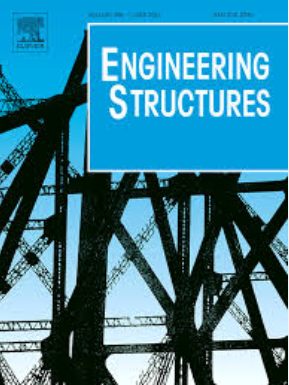Enhanced energy absorption and reusability of 3D printed continuous carbon fibre reinforced honeycomb beams under three-point bending loads
IF 5.6
1区 工程技术
Q1 ENGINEERING, CIVIL
引用次数: 0
Abstract
The integration of continuous carbon fibre (CCF) into 3D printing technology enables the fabrication of enhanced honeycomb structures. While CCF reinforcement demonstrates considerable potential for improving structural performance, comprehensive research is required to evaluate these fabricated honeycomb structures under bending loads, particularly regarding their shape-memory characteristics and reusability under cyclic loading conditions. This study investigates the response and energy absorption performance of novel reusable 3D-printed honeycomb beams reinforced with CCF under three-point bending loads through both experimental and numerical approaches. Specimens were manufactured using a dual-nozzle fused deposition modelling 3D printer by combining a thermoplastic polyurethane (TPU) matrix with varying CCF volume fractions. The mechanical behaviour was characterized through force-displacement curves obtained from monotonic and cyclic three-point bending experiments. Finite element models were developed and experimentally validated to simulate the mechanical responses, enabling parametric studies of CCF volume fraction and impact velocity effects. The cyclic bending experiments demonstrated reusability, with specimens maintaining at least 61 % of their initial energy absorption capacity after 10 cycles. Impact velocity proved to be a significant factor in honeycomb beam behaviour, with higher velocities leading to increased deformation and energy absorption. However, the incorporation of CCF introduced repulsive forces that caused fluctuations in force-displacement curves at higher speeds. Higher CCF volume fractions enhanced both load-bearing capacity and energy absorption, with the highest CCF content model achieving a 7.24 % weight reduction while improving energy absorption by 59.45 %. These findings provide valuable insights for designing reusable lightweight honeycomb beams with superior energy absorption capabilities.
求助全文
约1分钟内获得全文
求助全文
来源期刊

Engineering Structures
工程技术-工程:土木
CiteScore
10.20
自引率
14.50%
发文量
1385
审稿时长
67 days
期刊介绍:
Engineering Structures provides a forum for a broad blend of scientific and technical papers to reflect the evolving needs of the structural engineering and structural mechanics communities. Particularly welcome are contributions dealing with applications of structural engineering and mechanics principles in all areas of technology. The journal aspires to a broad and integrated coverage of the effects of dynamic loadings and of the modelling techniques whereby the structural response to these loadings may be computed.
The scope of Engineering Structures encompasses, but is not restricted to, the following areas: infrastructure engineering; earthquake engineering; structure-fluid-soil interaction; wind engineering; fire engineering; blast engineering; structural reliability/stability; life assessment/integrity; structural health monitoring; multi-hazard engineering; structural dynamics; optimization; expert systems; experimental modelling; performance-based design; multiscale analysis; value engineering.
Topics of interest include: tall buildings; innovative structures; environmentally responsive structures; bridges; stadiums; commercial and public buildings; transmission towers; television and telecommunication masts; foldable structures; cooling towers; plates and shells; suspension structures; protective structures; smart structures; nuclear reactors; dams; pressure vessels; pipelines; tunnels.
Engineering Structures also publishes review articles, short communications and discussions, book reviews, and a diary on international events related to any aspect of structural engineering.
 求助内容:
求助内容: 应助结果提醒方式:
应助结果提醒方式:


